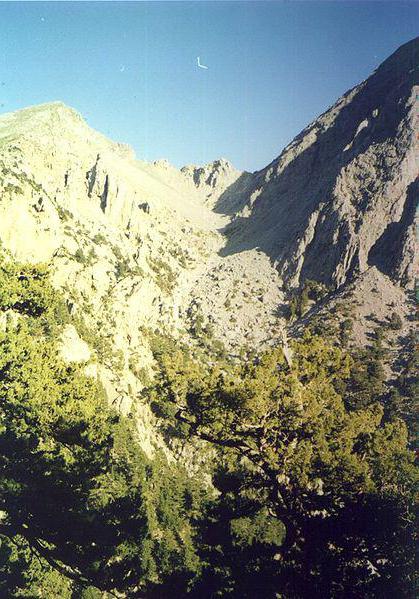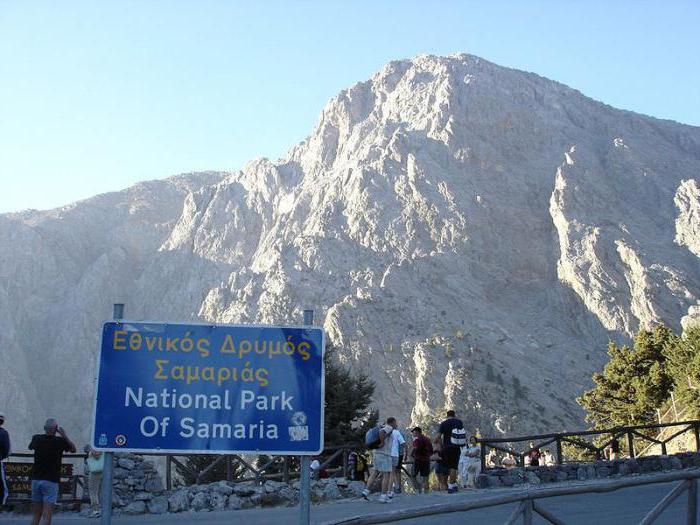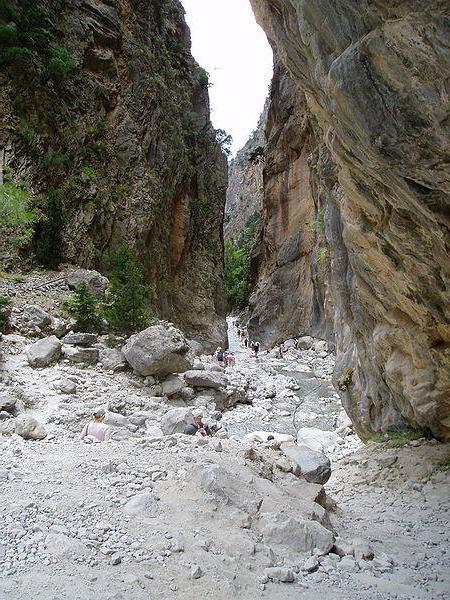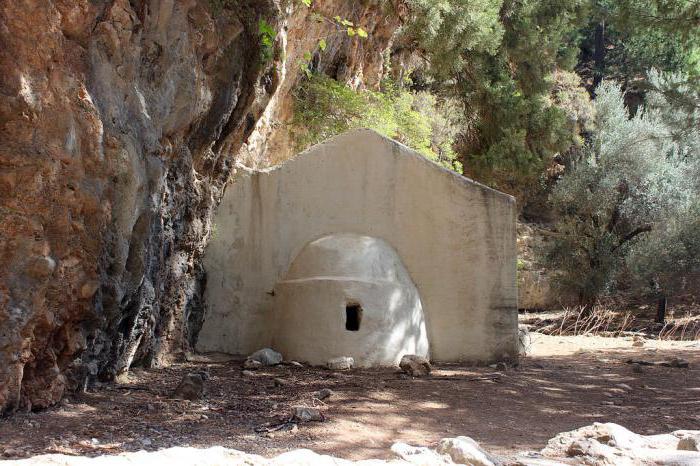Samaria Gorge (Chania, Crete, Greece) is the longest canyon in Europe. Several tens of thousands of tourists visit this attraction annually. All guides to Crete are advised to go - on their own or with a guided tour - to this gorge. Why is it so interesting? You will learn about this from our article. In the meantime, we are going on a journey. You will have to go along incline terrain, along a steep path. Therefore, shoes need to be taken suitable. The gorge is replete with fresh water sources. Therefore, it is enough to take an empty flask. The length of the gorge itself is thirteen kilometers. Two more need to be reached from the Xyloskalo point on the top of the mountain where the route begins. And then, leaving the gorge, it remains to walk another three kilometers to the nearest village of Agia Rumeli. So count your strengths. There are more gentle routes. You will not see all the beauty, but look at the main attractions. We will describe them below.

Samaria gorge in Greece: how to get there
This main natural attraction of Crete is located in the southwest of the island, in the area of the city of Chania. Samaria Gorge is located in the White Mountains (the Greek name is pronounced "Lefka Ori"). Most of Crete's attractions are easiest to visit with your own or rental car. But the Samaria gorge is not the case. You will have to go the same way twice to get back to the car. From Chania, you can take the Ktel bus to Ksiloskalo on the Omalos plateau in an hour. A hiking trail begins at this point. After eighteen kilometers of marvelous beauties, the road will lead you to the village of Agia Rumeli. Anendyk ferries regularly depart from her pier to the town of Chora Sfakion, and from there, regular buses leave for Chania, the second largest city in Crete.
Alternative routes
For those who know that they can’t handle the entire Samaria Gorge, the Crete guide offers two lightweight options. First: drive to Xyloskalo and go down the path-ladder that runs through a beautiful pine forest. Walk as much as you want, but taking into account the fact that you will repeat this whole path, but moving up. And the second option is for the laziest. Arrive in the village of Agia Rumeli and begin to climb to the lower exit of the gorge. You have to go three kilometers there and the same back. But in return you will see one of the most beautiful places of the Samaria canyon - "Iron Gate". There are no doors there. But in this place the gorge is the narrowest. Its width is only three meters. If you firmly decided to go the entire route, then plan at least five hours of travel (with a halt and photographing the beauties). All the way, but in the opposite direction, it will take you at least seven hours. After all, you will need to rise from the Libyan Sea to the top of the Omalos Plateau (1250 meters high).

History
The Samaria Gorge (Greece) was known to people during the time of the Crito-Mycenaean civilization. Proof of this are the ruins of ancient temples, which were supposedly dedicated to Artemis and Apollo. The Tarreos River flows along the bottom of the canyon. Most likely, in ancient times the gorge was called the same. At least the city, formed in the VI century BC behind the Iron Gate, was given the name Tarra. He was small but independent. Tarra minted her coin, on the obverse of which was the head of a local endemic, a mountain goat Kri-kri, and on the other hand a bee. The city reached its peak in the Roman period. Tarra is mentioned by Secliot, Diodorus and Pliny. When the island was owned by the Venetians, a village was located on the site of a once busy city. There was a Romanesque church dedicated to the Virgin. Its name (St. Mary - Osia Maria) and gave the name of the village, and along with the canyon.
Interesting Facts
The small Samaria Gorge nevertheless played a prominent role in the history of Greece. The Turkish yoke did not affect the inhabitants of Sfakia, who took refuge in these impregnable mountains. In fierce battles, the Greeks did not allow the Ottomans to pass the Iron Gate. The canyon was no less important in recent history. In the period 1935-1940. (known in Greece as the dictatorship of Metaxas), opposition leaders led by General Mandakas hid here. At the beginning of World War II, the path of the Greek government, which was sent to the Egyptian emigration, lay along the gorge. In 1942-43, detachments of fighters of the resistance movement of Hitler's occupation were stationed here. The partisans did not in the least prevent German scientists from conducting a comprehensive study of the fauna and flora of the Samaria Gorge and making a documentary about it. In the Civil War, the canyon became a haven for left-wing rebels who hid here until 1948. In 1962, it was decided to establish the White Mountains National Park here. Samaria residents were relocated to another place. Now the biosphere reserve occupies 4850 hectares.

Samaria Gorge (Crete, Greece): description
The Greek government created the reserve very on time, because virgin oak forests and cypress groves were cut down everywhere. Some species of animals and plants that lived and grew only on the island of Crete were on the verge of extinction. Now the populations are completely restored. Walking along the Samaria Gorge, we must not forget that this is the territory of the national park, and for the collection of plants and berries, felling trees for a fire and camping, there is a fine. After all, the canyon ecosystem is very fragile. It should be borne in mind that several thousand people pass through it daily. But tourists during such walks can see how wild goats Kri-kri jump on the rocks, notice a wild cat and marten scurrying in the branches, and follow the gaze of an eagle flying. The trail winds along the river bed, often crossing it. On the banks of the cliffs are steep cliffs overgrown with Cretan cypress, various types of pines, stone oak, plane trees, erondas, ebony.

When to visit Samaria Canyon
Summer in Crete is not conducive to long hikes. There can be more than thirty degrees in the shade. And in the gorge it becomes very stuffy. In addition, the river in the summertime turns into a half-dried brook. Winter for Crete is a rainy time. The river floods the entire gorge, moreover, because of heavy rains, landslides often occur. Therefore, since November, the passage through the canyon has been closed. The best time to visit a natural attraction is the first half of spring. The Samaria Gorge is blooming at this time. The river is very full and gives amazing freshness. Do not forget that about two hundred thousand tourists visit the reserve annually. At the peak of the season at the beginning of the trail accumulates up to three thousand tourists. Not all of them reach the end of the route. You can avoid traffic jams if you arrive on the Omalos plateau in the early morning. First, there is a long descent to the bottom of the gorge along the stairs. Untrained tourists after this escapade the next morning they have sore legs. The path at each kilometer is marked by wooden posts. Throughout the route there are places to relax. As a rule, tables are located near the springs with fresh water. There are toilets on the way. The staff of the national park is riding a mule.

Historical sights
The Samaria Gorge in Greece impresses with its pristine beauty. But not only wonderful views appear before the eyes of tourists. After all, this place was inhabited in the era of antiquity. In the Samaria Gorge (sometimes right next to the trail) there are several ancient temples. The Church of St. Nicholas was erected on the site of an ancient temple dedicated to Apollo or Artemis. You can see the ancient temple of Osia Maria, which gave the name of the village and the gorge. Among other historical and cultural attractions, one cannot but recall the church of St. Mary of Egypt of the 12th-13th centuries (with wonderful frescoes of 1740) and the church of Christ. The village of Samaria, empty in 1962, is located approximately in the middle of the route. Some houses with traditional Cretan architecture are now restored. In Samaria there is a pharmacy, a medical center, and in case of injuries to tourists - several mules and a helipad.
Tours and reviews about them
Samaria Gorge (Crete) is one of the ten “mast si” on the island. Back in the thirties of the twentieth century, the inhabitants of Samaria made a living by taking tourists to their canyon. Now on this sightseeing tour agencies profit. The cost of an organized visit to the Samaria Gorge varies from the point of departure. If you go there from the eastern parts of Crete, it will cost forty euros, and if from the western tip of the island, then thirty-five. Reviews warn: after paying for the tour, you will have to go through the entire route at a fairly cheerful pace. The bus will bring you to the plateau, and then meet you at the exit of the canyon. And keeping up with the group is easy. In this case, you will have to return home at your own expense.
Self-guided tours
This type of travel is recommended by all tourists. You depend on the schedule of buses and ferries, but in general - they are their own bosses. How much does such a trip cost? Travel by bus from Chania and back - fourteen euros, ferry - nine and a half. For the entrance to the Samaria Gorge will have to pay only 5 Є. In total, the whole trip will cost one person twenty eight euros with cents.
Reviews
Many irresponsible tourists regard the excursion to the Samaria Gorge as a visit to the botanical garden. But the rugged terrain very soon convinces them of the opposite. You need to be prepared for the campaign both in terms of equipment and in terms of health status. If you have sore feet, weak joints, heart problems and blood pressure, it is best to stay on the beach. In all other respects, tourists are satisfied with the trip. You will bring a lot of pleasant memories and gigabytes of wonderful photos from the Samaria Gorge.